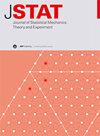从超对称量子视角看可逆马尔可夫跃迁过程的显式大偏差,以及对纯自旋链和随机自旋链的应用
IF 2.2
3区 物理与天体物理
Q2 MECHANICS
Journal of Statistical Mechanics: Theory and Experiment
Pub Date : 2024-07-09
DOI:10.1088/1742-5468/ad526d
引用次数: 0
摘要
我们从超对称量子哈密顿 H 的角度,重新审视了满足详细平衡的马尔可夫跳跃过程在不同层次上的大偏差。我们首先关注第 2 层的大偏差,即在大时间窗口内的轨迹中看到的构型 C 的经验密度,并将显式唐斯克-瓦拉丹速率函数重写为涉及平方根 ket 的矩阵元素(作为比较,我们还讨论了可逆扩散过程的类似公式)。然后,我们将考虑更高层次的显式速率函数,特别是经验密度的联合概率和表征两个构型之间跃迁密度的经验局部活动的显式速率函数。最后,经验密度和经验总活动的联合概率的显式速率函数代表了长轨迹的总跃迁密度,用两个矩阵元素 和 来表示,其中, 和 代表了超对称哈密顿 H 的对角线外部分。这个一般框架随后被应用于具有单旋翻转或双旋翻转转换速率的纯自旋链或随机自旋链,其中,超对称哈密顿 H 对应于具有涉及两个或三个相邻位点的保利矩阵的局部相互作用的量子自旋链。因此,引入与经验密度相关的量子密度矩阵,以便用只涉及两个或三个相邻位点的还原密度矩阵来重写各种速率函数,是非常有用的。本文章由计算机程序翻译,如有差异,请以英文原文为准。
A supersymmetric quantum perspective on the explicit large deviations for reversible Markov jump processes, with applications to pure and random spin chains
The large deviations at various levels that are explicit for Markov jump processes satisfying detailed balance are revisited in terms of the supersymmetric quantum Hamiltonian H that can be obtained from the Markov generator via a similarity transformation. We first focus on the large deviations at level 2 for the empirical density of the configurations C seen during a trajectory over the large time window , and rewrite the explicit Donsker–Varadhan rate function as the matrix element involving the square-root ket . (The analog formula is also discussed for reversible diffusion processes as a comparison.) We then consider the explicit rate functions at higher levels, in particular for the joint probability of the empirical density and the empirical local activities characterizing the density of jumps between two configurations . Finally, the explicit rate function for the joint probability of the empirical density and of the empirical total activity that represents the total density of jumps of a long trajectory is written in terms of the two matrix elements and , where represents the off-diagonal part of the supersymmetric Hamiltonian H. This general framework is then applied to pure or random spin chains with single-spin-flip or two-spin-flip transition rates, where the supersymmetric Hamiltonian H corresponds to quantum spin chains with local interactions involving Pauli matrices of two or three neighboring sites. It is then useful to introduce the quantum density matrix associated with the empirical density in order to rewrite the various rate functions in terms of reduced density matrices involving only two or three neighboring sites.
求助全文
通过发布文献求助,成功后即可免费获取论文全文。
去求助
来源期刊
CiteScore
4.50
自引率
12.50%
发文量
210
审稿时长
1.0 months
期刊介绍:
JSTAT is targeted to a broad community interested in different aspects of statistical physics, which are roughly defined by the fields represented in the conferences called ''Statistical Physics''. Submissions from experimentalists working on all the topics which have some ''connection to statistical physics are also strongly encouraged.
The journal covers different topics which correspond to the following keyword sections.
1. Quantum statistical physics, condensed matter, integrable systems
Scientific Directors: Eduardo Fradkin and Giuseppe Mussardo
2. Classical statistical mechanics, equilibrium and non-equilibrium
Scientific Directors: David Mukamel, Matteo Marsili and Giuseppe Mussardo
3. Disordered systems, classical and quantum
Scientific Directors: Eduardo Fradkin and Riccardo Zecchina
4. Interdisciplinary statistical mechanics
Scientific Directors: Matteo Marsili and Riccardo Zecchina
5. Biological modelling and information
Scientific Directors: Matteo Marsili, William Bialek and Riccardo Zecchina

 求助内容:
求助内容: 应助结果提醒方式:
应助结果提醒方式:


